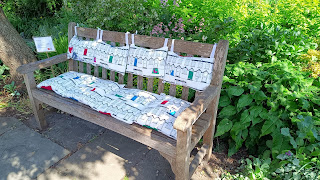Now that my project piece – Habitat – has been finished and displayed as part of the Saltaire Arts Trail organised by Saltaire Inspired, I can reflect on the project brief and whether there were any aspects I would consider changing.
Overall, I was really pleased with my design. Using the theme ‘A Sense of Togetherness, A Sense of Individuality’ I was happy with my digitally printed foundation design of monochrome buildings, as well as the individual elements that I added through hand-stitching. These two parts epitomised what the habitat of Saltaire meant to me.
As well as ‘habitat’ the project also has to consider sustainability and low-impact approaches to textile design and making. Digitally printing a cushion is not a natural process or outcome, however I tried to make sustainable choices throughout my creative process. Digital printing is less wasteful than other methods of printing (Wisbrun, 2011) and recycled, organic cotton and linen have less environmental impact than man made fabrics (Fletcher, 2008).
In addition I used a series of hand-stitch techniques in the creation of both my cushions and lampshades, and utilised items I had where possible rather than buying new. This included old denim shirts, plastic bags, inherited lampshades and vintage napkins. Selvedge waste was put to use to fringe the lampshades, old cushion fillers were re-used and off-cuts and end-of-roll fabric used for the cushion backs. I also worked hard to use as much of the printed fabric as possible through pattern placement, sewing scraps together for the lampshades for example, and using different shaped cushions.
Upon reflection, I would have liked to explore screen-printing further. As discussed previously, in my blog post on printing, while my current skill level meant I couldn’t achieve the look I wanted, I think with more practise, this design would work well using a screen-printing technique.
This is also the case with the added elements. I tried to plan the pattern and cushion placement to work with visitors’ seating. However, if the elements had been screen printed in place, there would be no concerns in terms of appliqued fabrics being ripped off, for example. The cushions would also be easier to reproduce for mass marketing purposes.
Chatting to visitors during the Arts Trail, I was delighted that residents of Saltaire and those familiar with the history recognised elements such as the washing line, cats and alpaca. One visitor even suggested mass producing the cushions!
This leads me on to the consideration of commercial avenues, since my project was product-led. At the time of writing, one venue in Saltaire has agreed to sell some cushions with my black and white design. However, I plan to recreate the cushion design complete with colour pops digitally and look to sell these too.
Sources
Dunphy, N (2023) Design and Trends Research.
Bird, J. (2018). Fashion’s Dirty Little
Secret. [Online] Available from: https://www.forbes.com. [Accessed 19 January 2023]
Garcia, L. (2019) Filipiniana Dresses and How They’ve Changed
Throughout History [Online] Available from: https://www.filipinowedding.com/blogs. [Accessed 13 October 2022]
https://inchyra.com/
https://johnlewis.com
Wisbrun, L. (2011) The Complete Guide to Designing
and Printing Fabric. A & C Black Publishers Limited





Comments
Post a Comment